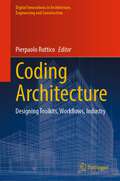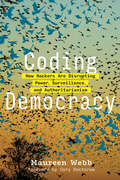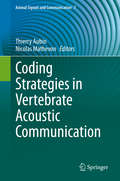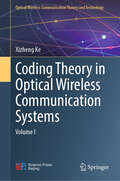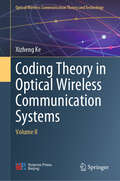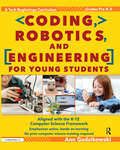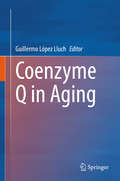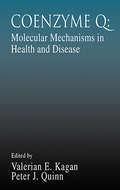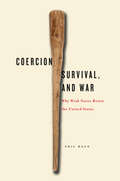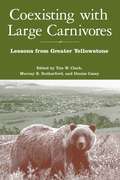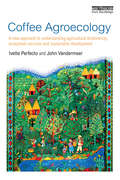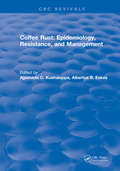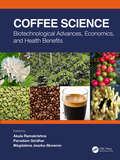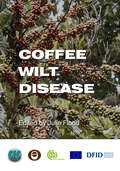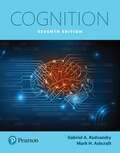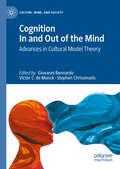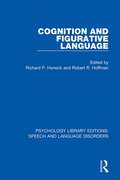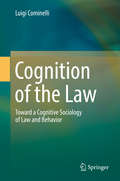- Table View
- List View
Codes: How to Make Them and Break Them! (Murderous Maths Ser.)
by Ian Baker Kjartan PoskittDid you ever want to send a message that only your friend can read? Or did you want to try and uncover a secret communication from someone else? If so, then here's everything you need to know about creating and cracking codes-from the simplest substitution messages to the secrets of the well-known World War II coding contraption, the amazing Enigma Machine!The book includes information about:Substitution codesScrambling codesCodes containing unrecognizable symbolsOther message systems such as Morse code and flagsAnd how to make your own Enigma machine!You’ll be thrilled as this amusing book takes you on a codebreaking adventure, learning ways to decode both simple and difficult puzzles, as well as provides you with a history on the cryptology. Filled with tips and enjoyable illustrations by Ian Baker, Codes will have you sending secret messages in no time.
Coding Architecture: Designing Toolkits, Workflows, Industry (Digital Innovations in Architecture, Engineering and Construction)
by Pierpaolo RutticoThis book provides a clear picture of how computational processes are gradually permeating and innovating the Architecture, Engineering, and Construction sector, contributing to sustainability and aesthetic evolution. It achieves that by gathering a collection of accounts shared by pioneering professionals involved in this innovation, drawing from recent academic studies, ongoing experimental processes conducted in cutting-edge architectural and engineering offices, as well as innovative industrial applications. The covered subjects span a wide range, including artificial intelligence and robotic manufacturing, the metaverse and 3D printing, strategies to counter CO2 consumption through plug-ins, as well as emerging materials and construction techniques. The chapters feature authors who are pioneers and embrace roles like software developers, architects, process engineers, academics, and forward-thinking entrepreneurs. They represent authoritative references within a broader interconnected cultural and technological system; an eclectic system that finds in computational processes the key to addressing the new challenges of contemporary architecture.
Coding Democracy: How Hackers Are Disrupting Power, Surveillance, and Authoritarianism (The\mit Press Ser.)
by Maureen WebbHackers as vital disruptors, inspiring a new wave of activism in which ordinary citizens take back democracy.Hackers have a bad reputation, as shady deployers of bots and destroyers of infrastructure. In Coding Democracy, Maureen Webb offers another view. Hackers, she argues, can be vital disruptors. Hacking is becoming a practice, an ethos, and a metaphor for a new wave of activism in which ordinary citizens are inventing new forms of distributed, decentralized democracy for a digital era. Confronted with concentrations of power, mass surveillance, and authoritarianism enabled by new technology, the hacking movement is trying to “build out” democracy into cyberspace.Webb travels to Berlin, where she visits the Chaos Communication Camp, a flagship event in the hacker world; to Silicon Valley, where she reports on the Apple-FBI case, the significance of Russian troll farms, and the hacking of tractor software by desperate farmers; to Barcelona, to meet the hacker group XNet, which has helped bring nearly 100 prominent Spanish bankers and politicians to justice for their role in the 2008 financial crisis; and to Harvard and MIT, to investigate the institutionalization of hacking. Webb describes an amazing array of hacker experiments that could dramatically change the current political economy. These ambitious hacks aim to displace such tech monoliths as Facebook and Amazon; enable worker cooperatives to kill platforms like Uber; give people control over their data; automate trust; and provide citizens a real say in governance, along with capacity to reach consensus. Coding Democracy is not just another optimistic declaration of technological utopianism; instead, it provides the tools for an urgently needed upgrade of democracy in the digital era.
Coding Strategies in Vertebrate Acoustic Communication (Animal Signals and Communication #7)
by Thierry Aubin Nicolas MathevonInformation is a core concept in animal communication: individuals routinely produce, acquire, process and store information, which provides the basis for their social life. This book focuses on how animal acoustic signals code information and how this coding can be shaped by various environmental and social constraints. Taking birds and mammals, including humans, as models, the authors explore such topics as communication strategies for “public” and “private” signaling, static and dynamic signaling, the diversity of coded information and the way information is decoded by the receiver. The book appeals to a wide audience, ranging from bioacousticians, ethologists and ecologists to evolutionary biologists. Intended for students and researchers alike, it promotes the idea that Shannon and Weaver’s Mathematical Theory of Communication still represents a strong framework for understanding all aspects of the communication process, including its dynamic dimensions.
Coding Theory in Optical Wireless Communication Systems: Volume I (Optical Wireless Communication Theory and Technology)
by Xizheng KeThis book focuses on optical-wireless communication systems. It summarizes the author's optical-wireless communication coding work while carrying out pertinent scientific research programs. The primary topics covered in the book are channel coding, coding modulation, error control (channel coding), and channel equalization. The author's mathematical analysis and experimental studies on the key theoretical issues are discussed in the book. One of the book's outstanding aspects is its thorough and methodical discussion of practical optical-wireless communication challenges. This makes the book especially appealing to readers who are eager to learn about applicable solutions in this area. Researchers, engineers, and graduate students in the subject of telecommunications can all profit from the book. It is appropriate for senior undergraduates, lecturers at colleges and universities, graduate students, and engineering and technical workers involved in optical communication.
Coding Theory in Optical Wireless Communication Systems: Volume II (Optical Wireless Communication Theory and Technology)
by Xizheng KeThis book focuses on optical-wireless communication systems. It summarizes the author's optical-wireless communication coding work while carrying out pertinent scientific research programs. The primary topics covered in the book are channel coding, coding modulation, error control (channel coding), and channel equalization. The author's mathematical analysis and experimental studies on the key theoretical issues are discussed in the book. One of the book's outstanding aspects is its thorough and methodical discussion of practical optical-wireless communication challenges. This makes the book especially appealing to readers who are eager to learn about applicable solutions in this area. Researchers, engineers, and graduate students in the subject of telecommunications can all profit from the book. It is appropriate for senior undergraduates, lecturers at colleges and universities, graduate students, and engineering and technical workers involved in optical communication.
Coding and Decoding of Calcium Signals in Plants (Signaling and Communication in Plants #10)
by Sheng LuanPlants cannot move away from their environments. As a result, all plants that have survived to date have evolved sophisticated signaling mechanisms that allow them to perceive, respond, and adapt to constantly changing environmental conditions. Among the many cellular processes that respond to environmental changes, elevation of calcium levels is by far the most universal messenger that matches primary signals to cellular responses. Yet it remains unclear how calcium, a simple cation, translates so many different signals into distinct responses - how is the "specificity" of signal-response coupling encoded within the calcium changes? This book will attempt to answer this question by describing the cellular and molecular mechanisms underlying the coding and decoding of calcium signals in plant cells.
Coding, Robotics, and Engineering for Young Students: A Tech Beginnings Curriculum (Grades Pre-K-2)
by Ann GadzikowskiCoding, Robotics, and Engineering for Young Students builds foundational computer science and robotics skills and knowledge in bright Pre-K-grade 2 students. Originally developed as enrichment courses for Northwestern University's Center for Talent Development, this curriculum emphasizes active, hands-on, and collaborative learning. Students are challenged to learn computer science content, such as coding, and robotics and engineering concepts, as well as practice high-level academic skills, such as creative problem solving, computational thinking, and critical thinking. Instructional practices balance screen time with active, collaborative classroom engagement. Learning is deepened when students are challenged to navigate the transition from a virtual learning environment to a tangible learning environment. The lessons can be implemented as standalone enrichment experiences or as part of a coordinated scope and sequence that leads to higher level computer science and engineering studies.Grades Pre-K-2
Coenzyme Q in Aging
by Guillermo López LluchThis book offers a comprehensive exploration of research on the essential relationship of the coenzyme Q10 and the process of aging in living organisms. CoQ10 is an important factor in two main aspects of cell physiology: bioenergetics and antioxidant protection. While primary deficiency of CoQ10 is associated with severe and lethal disease, secondary deficiency can be associated with the progression of mitochondrial dysfunction linked to the lessening of biological activities during aging. The book is organized in four sections. The first offers an overview of the function of CoQ10, highlighting the two main functions of CoQ10 in cells: its essential role as electron transport chain member in mitochondria, and the protection of cell membranes against oxidation as one of the main endogenous-synthesized antioxidants. The second section covers research on Coenzyme 10. Topics include studies involving invertebrate models, mammal studies and the influence of CoQ on longevity. Also covered is research involving the role of CoQ in senescence-accelerated mice. Section three examines the effects of reduced CoQ in human aging, as evident in mitochondrial dysfunction, metabolic syndrome, neurodegenerative disorders, immunosenescence and fertility and reproduction. The final section, Prolongevity effectors and Coenzyme Q, explores research into slowing or stopping the aging process. Coverage includes strategies including calorie restriction, and modulation of CoQ10 levels by induction of synthesis or by supplementation. Coenzyme Q in Aging benefits a broad readership of researchers, clinicians, educators and students interested in the biochemical and physiological effects of coenzyme Q and the importance of this molecule in aging process.
Coenzyme Q: Molecular Mechanisms in Health and Disease (Modern Nutrition)
by Peter J. Quinn Valerian E. KaganSince its discovery in 1957, Coenzyme Q has piqued the interest of scientists from a wide range of disciplines because of its bioenergetics, vitamin-like behavior, and interactions with antioxidant vitamins E and C. Coenzyme Q: Molecular Mechanisms in Health and Disease is a comprehensive treatise on this often-studied coenzyme. International exper
Coercion, Survival, and War: Why Weak States Resist the United States
by Phil HaunIn asymmetric interstate conflicts, great powers have the capability to coerce weak states by threatening their survival--but not vice versa. It is therefore the great power that decides whether to escalate a conflict into a crisis by adopting a coercive strategy. In practice, however, the coercive strategies of the U. S. have frequently failed. In Coercion, Survival and War Phil Haun chronicles 30 asymmetric interstate crises involving the US from 1918 to 2003. The U. S. chose coercive strategies in 23 of these cases, but coercion failed half of the time: most often because the more powerful U. S. made demands that threatened the very survival of the weak state, causing it to resist as long as it had the means to do so. It is an unfortunate paradox Haun notes that, where the U. S. may prefer brute force to coercion, these power asymmetries may well lead it to first attempt coercive strategies that are expected to fail in order to justify the war it desires. He concludes that, when coercion is preferred to brute force there are clear limits as to what can be demanded. In such cases, he suggests, U. S. policymakers can improve the chances of success by matching appropriate threats to demands, by including other great powers in the coercive process, and by reducing a weak state leader's reputational costs by giving him or her face saving options.
Coevolution of Life on Hosts: Integrating Ecology and History (Interspecific Interactions Ser.)
by Dale H. Clayton Kevin P. Johnson Sarah E. BushFor most, the mere mention of lice forces an immediate hand to the head and recollection of childhood experiences with nits, medicated shampoos, and traumatic haircuts. But for a certain breed of biologist, lice make for fascinating scientific fodder, especially enlightening in the study of coevolution. In this book, three leading experts on host-parasite relationships demonstrate how the stunning coevolution that occurs between such species in microevolutionary, or ecological, time generates clear footprints in macroevolutionary, or historical, time. By integrating these scales, Coevolution of Life on Hosts offers a comprehensive understanding of the influence of coevolution on the diversity of all life. Following an introduction to coevolutionary concepts, the authors combine experimental and comparative host-parasite approaches for testing coevolutionary hypotheses to explore the influence of ecological interactions and coadaptation on patterns of diversification and codiversification among interacting species. Ectoparasites—a diverse assemblage of organisms that ranges from herbivorous insects on plants, to monogenean flatworms on fish, and feather lice on birds—are powerful models for the study of coevolution because they are easy to observe, mark, and count. As lice on birds and mammals are permanent parasites that spend their entire lifecycles on the bodies of their hosts, they are ideally suited to generating a synthetic overview of coevolution—and, thereby, offer an exciting framework for integrating the concepts of coadaptation and codiversification.
Coexisting with Large Carnivores: Lessons From Greater Yellowstone
by Murray Rutherford Denise Casey Tim ClarkAs in the rest of the United States, grizzly bears, wolves, and mountain lions in and around Yellowstone National Park were eliminated or reduced decades ago to very low numbers. In recent years, however, populations have begun to recover, leading to encounters between animals and people and, more significantly, to conflicts among people about what to do with these often controversial neighbors. Coexisting with Large Carnivores presents a close-up look at the socio-political context of large carnivores and their management in western Wyoming south of Yellowstone National Park, including the southern part of what is commonly recognized as the Greater Yellowstone Ecosystem. The book brings together researchers and others who have studied and worked in the region to help untangle some of the highly charged issues associated with large carnivores, their interactions with humans, and the politics that arise from those interactions. This volume argues that coexistence will be achieved only by a thorough understanding of the human populations involved, their values, attitudes, beliefs, and the institutions through which carnivores and humans are managed. Coexisting with Large Carnivores offers important insights into this complex, dynamic issue and provides a unique overview of issues and strategies for managers, researchers, government officials, ranchers, and everyone else concerned about the management and conservation of large carnivores and the people who live nearby.
Coffee Agroecology: A New Approach to Understanding Agricultural Biodiversity, Ecosystem Services and Sustainable Development
by Ivette Perfecto John VandermeerBased on principles of the conservation and optimization of biodiversity and of equity and sustainability, this book focuses on the ecology of the coffee agroecosystem as a model for a sustainable agricultural ecosystem. It draws on the authors' own research conducted over the last twenty years as well as incorporating the vast literature that has been generated on coffee agroecosystems from around the world. The book uses an integrated approach that weaves together various lines of research to understand the ecology of a very diverse tropical agroforestry system. Key concepts explored include biodiversity patterns, metapopulation dynamics and ecological networks. These are all set in a socioeconomic and political framework which relates them to the realities of farmers' livelihoods. The authors provide a novel synthesis that will generate new understanding and can be applied to other examples of sustainable agriculture and food production. This synthesis also explains the ecosystem services provided by the approach, including the economic, fair trade and political aspects surrounding this all-important global commodity.
Coffee Rust: Epidemiology, Resistance and Management
by Ajjamada C. KushalappaThis highly informative monograph will provide a basic reference on coffee rust for both investigators in the field and those entering it. The research conducted has been organized based on principles of epidemiology and plant disease management, providing both theoretical and practical information. This approach enables discussion of the past, present and future of coffee rust research in broad plant patholog-ical areas of biology, epidemiology, genetics and breeding for disease resistance, fungicide technology and application, and disease management. In addition, an analysis of epidemics, breeding programs, and other rust management practices in India, Kenya and Brazil are included. This new text will contain over 45 figures and 40 tables for both investigators in the field and those just entering it.
Coffee Science: Biotechnological Advances, Economics, and Health Benefits
by Akula Ramakrishna Magdalena Jeszka-Skowron Parvatam GiridharCoffee Science: Biotechnological Advances, Economics and Health Benefits highlights the important advances in coffee research and an all-inclusive collection of information on the current status of global coffee production and market, sustainable benefits, novel methods and recent developments in coffee metabolites analysis, advancements in coffee processing technology and improvement of coffee quality by fermentation, solid-liquid extraction methods, and post-harvesting processes to improve the beverage quality and produce coffees with different sensory profiles. The book compiles insights into the biotechnological advances to improve coffee quality. It also describes specialty coffees, which are gaining consumer acceptance and enjoying a good global market. This book collates work on the influence of various coffee metabolites such as methyl xanthine, polyphenols, phenolic compounds, indoleamines, biogenic amines, and coffee diterpenes in human health effects such as cardiovascular diseases, cancer, type 2 diabetes mellitus, Alzheimer’s disease, and Parkinson’s disease. This book is a useful resource for scientists, academicians, and professionals all over the world who are engaged in coffee cultivation, research, business and coffee consumers’ health. Key Features Current status on coffee production and the global market Novel methods and recent developments in the determination of coffee metabolites Advancements in coffee bean processing technology and improvement of coffee quality Biotechnological advances to improve coffee quality: The role of molecular markers, tissue culture, transgenic technology, and micro RNAs Effects of coffee consumption on human health Knowledge contributions from acknowledged experts from across the world
Coffee Wilt Disease
by Julie FloodCoffee Wilt Disease has cost African coffee farmers an estimated $1 billion to date, resulting from reduced yields and the extra costs incurred in trying to manage the disease.
Coffee, Tea, Chocolate, and the Brain (Nutrition, Brain And Behavior Ser. #Vol. 2)
by Astrid NehligCoffee, tea, and chocolate are among the most frequently consumed products in the world. The pleasure that many experience from these edibles is accompanied by a range of favorable and adverse effects on the brain that have been the focus of a wealth of recent research. Coffee, Tea, Chocolate, and the Brain presents new information on the
Cognition
by Gabriel Radvansky Mark AshcraftCognition, Seventh Edition is also available via Revel™, an interactive learning environment that enables students to read, practice, and study in one continuous experience.
Cognition In and Out of the Mind: Advances in Cultural Model Theory (Culture, Mind, and Society)
by Victor C. de Munck Giovanni Bennardo Stephen ChrisomalisThis edited collection presents an agenda for the interdisciplinary study of anthropology and cognitive science. It consists of fifteen chapters written by international experts on the relationship between culture and cognition. This volume is unique in that it includes both inside (i.e., shared mental templates) and outside (i.e., extended, embedded, enactive and ecological) theories of cognition. The contributors come from the diverse disciplinary fields of anthropology, linguistics, archaeology, and cognitive science. The aim is to investigate the mental production of shared knowledge, goals, and desires around which human social life revolves. The coverage spans cultural and linguistic evolution, the importance of local histories, and the role of cultural models to understand and interact with the world. Drawing on cultural model theory, this volume is an invaluable resource for linguists, cognitive scientists, anthropologists, and other social scientists willing to explore and understand how the sharedness of culture can bond us all together across relative cultural differences and (mis)perceived divisions.
Cognition and Figurative Language (Psychology Library Editions: Speech and Language Disorders)
by Robert R. Hoffman Richard P. HoneckOriginally published in 1980, this is a book about the psychology of figurative language. It is however, eclectic and therefore should be of interest to professionals and students in education, linguistics, philosophy, sociolinguistics, and other concerned with meaning and cognition. The editors felt there was a pressing need to bring together the growing empirical efforts of this topic. In a sense, recognition of the theoretical importance of figurative language symbolized the transition from the psycholinguistics of the 1960s to that of the late 1970s, that is from a linguistic semantics to a more comprehensive psychological semantics with a healthy respect for context, inference, world knowledge, and above all creative imagination. The organization of the volume reflects the more basic, general concerns with cognition – from historical and philosophical background, through problems of mental representation and semantic theory, to developmental trends, and to applications in problem solving.
Cognition and Neuropsychology: International Perspectives on Psychological Science (Volume 1)
by Peter A. FrenschThis is the first of two volumes which together present the main contributions from the 29th International Congress of Psychology, held in Berlin in 2008, written by international leaders in psychology from around the world. The authors present a variety of approaches and perspectives that reflect cutting-edge advances in psychological science. Cognition and Neuropsychology is dedicated to summarizing and characterizing the current scientific research in three substantive content areas, (i) Perception, Attention, and Action, (ii) Social Cognition, and (iii) Learning, Memory and Development. While some of the contributions focus on relatively narrow areas of research, others adopt a much broader stance, trying to understand and explain many different facets of behaviour across widely differing situations. Some contributions even try to bridge the fundamental gap between behaviour and genetics. The final part contains two chapters that discuss fundamental general issues in psychology, such as the fate of mentalism and the significance of phenomenal analyses. All chapters offer fascinating insights into current theorizing on the mind, and are written by some of the best-known scholars of our time. This book will be an invaluable resource for researchers, professionals, teachers and students in the field of psychology.
Cognition and the Brain
by Andrew Brook Kathleen AkinsAn up-to-date and comprehensive overview of the philosophy and neuroscience movement.
Cognition of the Law: Toward a Cognitive Sociology of Law and Behavior
by Luigi CominelliThis book’s basic hypothesis – which it proposes to test with a cognitive-sociological approach – is that legal behavior, like every form of human behavior, is directed and framed by biosocial constraints that are neither entirely genetic nor exclusively cultural. As such, from a sociological perspective the law can be seen as a super-meme, that is, as a biosocial constraint that develops only in complex societies. This super-meme theory, by highlighting a fundamental distinction between defensive and assertive biases, might explain the false contradiction between law as a static and historical phenomenon, and law as a dynamic and promotional element. Socio-legal scholars today have to face the challenge of pursuing a truly interdisciplinary approach, connecting all the fields that can contribute to building a modern theory of normative behavior and social action. Understanding and framing concepts such as rationality, emotion, or justice can help to overcome the significant divide between micro and macro sociological knowledge. Social scientists who are interested in the law must be able to master the epistemological discourses of different disciplines, and to produce fruitful syntheses and bridge-operations so as to understand the legal phenomenon from each different point of view. The book adopts four perspectives: sociological, psychological, biological-evolutionary and cognitive. All of them have the potential to be mutually integrated, and constitute that general social science that provides common ground for exchange. The goal is to arrive at a broad and integrated view of the socio-legal phenomenon, paving the way for a comprehensive theory of norm-oriented and norm-perceived actions.
Cognition-Based Evolution: Natural Cellular Engineering and the Intelligent Cell
by William B. MillerCognition-Based Evolution is the first comprehensive alternative to 20th-century Neodarwinism, proposing a radical 21st-century evolutionary framework with a novel point of origination: all cells are intelligent and must measure uncertain environmental information to sustain themselves. In Cognition-Based Evolution, life is defined by cognition. From this differential stance, evolutionary biology transforms into the science of why, how, what, and with whom cells measure and communicate under stressful environmental conditions. Life's context is uncertain environmental information, communication is its means, and genes are its tools. Evolution is its yield as continuous non-random self-referential cellular problem-solving.

